From Supernatural to Ornamental: Black Elder (Sambucus nigra L., Family Adoxaceae) in Sweden
Abstract
1. Introduction
1.1. Background
1.2. Biology
1.3. Distribution and Ecology
1.4. Research Aim
2. Results
2.1. Historical Context
2.2. Cultivation History
2.3. Home of a Supernatural Being and Other Folklore
2.4. Medicinal Plant
2.5. Handicraft and Toys
2.6. Miscellaneous Uses
2.7. Ornamental Shrub
2.8. Innovative Food
2.8.1. Elderflower Cordial
2.8.2. Commercial Production
2.9. Contemporary Multi-Purpose Use
2.10. Future Prospects
3. Materials and Methods
Data Collection and Analysis
4. Discussion
5. Conclusions
Author Contributions
Funding
Data Availability Statement
Acknowledgments
Conflicts of Interest
References
- Magnus, R.; Sander, H. Urban trees as social triggers: The case of the Ginkgo biloba specimen in Tallinn, Estonia. Sign Syst. Stud. 2019, 47, 234–256. [Google Scholar] [CrossRef]
- Rohde Sloth, P.; Lund Hansen, U.; Karg, S. Viking Age garden plants from southern Scandinavia—Diversity, taphonomy and cultural aspects. Dan. J. Archaeol. 2012, 1, 27–38. [Google Scholar] [CrossRef][Green Version]
- Atkinson, M.D.; Atkinson, E. Sambucus nigra . J. Ecol. 2002, 90, 895–923. [Google Scholar] [CrossRef]
- Available online: https://giftinformation.se/vaxtregister/flader/?listPageId=2416 (accessed on 10 September 2024).
- Grant, E. Attempted Quantification of the Cyanogenic Glycosides Prunasin and Sambunigrin in the Sambucus L. (Elderberry). Honors College, Atlanta, GA, USA, 2016. Honors Thesis. Available online: https://digitalcommons.library.umaine.edu/honors/389 (accessed on 1 October 2024).
- Raab-Straube, E. Viburnaceae. In Euro + Med Plantbase—The Information Resource for Euro-Mediterranean Plant Diversity; Euro-Mediterranean Human Rights Monitor: Geneva, Switzerland, 2017. [Google Scholar]
- SLU Swedish Species Information Centre. Artfakta: Fläder Sambucus nigra. 2024. Available online: https://artfakta.se/taxa/221576 (accessed on 10 September 2024).
- Jensen, H.-A. Catalogue of Late- and Postglacial Macrofossils of Spermatophyta from Denmark, Schleswig, Scania, Halland, and Blekinge Dated 13.000 B.P. to 1536 A.D. (=Danm. Geol. Undersøg., Ser. A:6); C.A.; Reitzels Forlag: Copenhagen, Denmark, 1985. [Google Scholar]
- Hjelmqvist, H. Några trädgårdsväxter från Lunds medeltid. Svensk Bot. Tidskr. 1991, 85, 225–248. [Google Scholar]
- Brøndegaard, V.J. Folk og Flora. Dansk Etnobotanik; Rosenkilde og Bagger: København, Denmark, 1980; Volume 4. [Google Scholar]
- Lempiäinen, T. Om trädgårdskonstens och trädgårdsodlingens historia i Finland: Skriftliga, språkliga och arkeobotaniska källor. In Sources to the History of Gardening: Four Interdisciplinary Seminars 2010–2013 Arranged by the Nordic Network for the Archaeology and Archaeobotany of Gardening (NTAA); Andréasson, A., Gräslund Berg, E., Heimdahl, J., Jakobsson, A., Larsson, I., Persson, E., Eds.; (=Rapport 2014:2); Sveriges Lantbruksuniversitet: Alnarp, Sweden, 2024; pp. 251–259. [Google Scholar]
- Linnaeus, C. Frutetum svecicum, quod, consens. experient. Facult. Medic. in Illustri Lycæo Upsal., Præside... Dn. Doct. Caroli Linnæi... Publico erudit. Exam. Modeste Subjicit... David Magn. Virgander, Smolandus; L.M. Höjer: Upsala, Sweden.
- Lagerås, P. Long-term development of landscape openness and arable land use in an agricultural region of southern Sweden: The potential of REVEALS estimates using pollen records from wells. Veg. Hist. Archaeobot. 2020, 29, 113–124. [Google Scholar] [CrossRef]
- Fischerström, J. Utkast til Beskrifning om Mälaren; J. C. Holmberg: Stockholm, Sweden, 1785. [Google Scholar]
- Linnaeus, C. Öländska och Gothländska Resa på Riksens Högloflige Ständers Befallning Förrättad Åhr 1741; Gottfried Kiesewetter: Stockholm, Sweden, 1745. [Google Scholar]
- Linnaeus, C. Skånska Resa, på Höga Öfwerhetens Befallning Förrättad År 1749; Lars Salvius: Stockholm, Sweden, 1751. [Google Scholar]
- Linnaeus, C. Flora Svecica; Laurentius Salvius: Stockholm, Sweden, 1755. [Google Scholar]
- Retzius, A.J. Försök til en Flora Oeconomica Sveciæ, Eller Swenska Wäxters Nytta 2; Joh. Lundblad: Lund, Sweden, 1806. [Google Scholar]
- Wikström, J.E. Stockholms Flora, Eller Kort Beskrifning af de vid Stockholm i Vildt Tillstånd Förekommande Växter; Norstedt & Söner: Stockholm, Sweden, 1840. [Google Scholar]
- Thorsén, E. Uppländskt Torparliv; Nordiska Museet: Stockholm, Sweden, 1949. [Google Scholar]
- Swedish Institute for Language and Folklore, Uppsala: Folklife records: ULMA 34418 (Medåker, Vstml.) Manuscript.
- Malmgren, U. Västmanlands Flora; Naturvetenskapliga Forskningsrådet: Stockholm, Sweden, 1982. [Google Scholar]
- Wigström, E. Folktro och säger. In Nyare Bidrag till Svenska Landsmålen ock Svenskt Folklif; Samson & Wallin: Stockholm, Sweden, 1898; Volume VII, 5–84. [Google Scholar]
- Tillhagen, C.-H. Skogarna och Träden; Carlssons: Stockholm, Sweden, 1995. [Google Scholar]
- Lithberg, N. Naturens almanacka. Folk. Och Folk. 1931, 18, 97–106. [Google Scholar]
- Allen, D.E.; Hatfield, G. Medicinal Plants in Folk Tradition: An Ethnobotany of Britain and Ireland; Timber Press: Portland, OR, USA, 2004. [Google Scholar]
- Henriksson, J. Växterna i de Gamlas Föreställningar, Seder och Bruk; Palmquist: Stockholm, Sweden, 1911. [Google Scholar]
- Bondeson, A. Om folkets läkekonst i mellersta Halland. Upps. Läkareförenings Handl. 1881, 16, 214–221. [Google Scholar]
- Swedish Institute for Language and Folklore. Uppsala: Folklife records: ULMA 20452 (Hellvi, Gotland) Manuscript.
- Lindgren, J. Läkemedelsnamn. Ordförklaring och Historik; Gleerups: Lund, Sweden, 1918. [Google Scholar]
- Rosendahl, H.V. Lärobok i Farmakognosi; W. Schultz: Uppsala, Sweden, 1897. [Google Scholar]
- Emsheimer, E. Tollabössa och videpipa. In Sumlen: Årsbok för Vis- Och Folkmusikforskning; Samfundet för Visforskning: Stockholm, Sweden, 1984; pp. 9–24. [Google Scholar]
- Palmstruch, J.W. Svensk Botanik 1; Carl Delén: Stockholm, Sweden, 1815. [Google Scholar]
- Armfelt-Hansell, Ö. Mormors Sylt och Farmors Saft: Bär-Och Fruktrecept ur Gamla Kokböcker; Norstedt: Stockholm, Sweden, 1969. [Google Scholar]
- Olsson, B. Safta, sylta, konservera. In Text och Recept ICAS Provkök; ICA-Förlaget: Västerås, Sweden, 1972. [Google Scholar]
- Treptow, H. Schwarzer Holunder (Sambucus nigra L.) und seine Verwendung. Ernaehr.-Umsch. 1985, 32, 296–300. [Google Scholar]
- Kaack, K. Juice processing from elderberry (Sambucus nigra L.). Tidsskr. Planteavl. 1989, 93, 365–368. [Google Scholar]
- Sala, G.; Pasta, S.; Maggio, A.; La Mantia, T. Sambucus nigra L. (fam. Viburnaceae) in Sicily: Distribution, ecology, traditional use and therapeutic properties. Plants 2023, 12, 3457. [Google Scholar] [CrossRef] [PubMed]
- Vallès, J.; Àngels Bonet, M.; Agelet, A. Ethnobotany of Sambucus nigra L. in Catalonia (Iberian Peninsula): The integral exploitation of a natural resource in mountain regions. Econ. Bot. 2002, 58, 456–469. [Google Scholar] [CrossRef]
- Knudsen, B.F.; Knack, K.V. A review of traditional herbal medicinal products with disease claims for elder (Sambucus nigra) flower. Acta Hortic. 2015, 1061, 109–120. [Google Scholar] [CrossRef]
- Høeg, O.A. Planter og Tradisjon: Floraen i Levende Tale og Tradisjon i Norge 1925–1973; Universitetsforlaget: Oslo, Norway, 1974. [Google Scholar]
- Klementtilä, H.; Jaakola, L. Mansimarjasta Punapuolaan: Marjakasvien Kulttuurihistoriaa; Maahenki: Helsinki, Finland, 2011. [Google Scholar]
- Svanberg, I. The use of wild plants as food in pre-industrial Sweden. Acta Soc. Bot. Pol. 2012, 81, 317–327. [Google Scholar] [CrossRef]
- Bergström, P. Safthushållning: Från Violsaft och Fläderdricka till Krusbärssaft och Lingonglögg; Natur och Kultur: Stockholm, Sweden, 2017. [Google Scholar]
- Feldt, M. Det växer Saft och Sylt Överallt. Recept och Berättelser; Bonnier: Stockholm, Sweden, 2023. [Google Scholar]
- Society of Ethnobiology: What Is Ethnobiology? Available online: https://ethnobiology.org/about-ethnobiology/what-is-ethnobiology (accessed on 20 September 2024).
- Myrdal, J. Source pluralism as a method of historical research. In Historical Knowledge: In Quest of Theory, Method and Evidence; Hellman, S., Rahikainen, M., Eds.; Cambridge Scholars Publishing: Newcastle upon Tyne, UK, 2012; pp. 155–189. [Google Scholar]
- Swedish Institute for Language and Folklore. Uppsala: Questionnaire ULMA 188 ‘Vård och Användning av Vilda Träd, Buskar och Örter på Inägomark’.
- The Program for Diversity of Cultivated Plants, SLU, Alnarp: Hjalmarsson I. POM Bär-Och Fruktuppropet: Fläder Sambucus nigra. Available online: https://www.slu.se/globalassets/ew/org/centrb/pom/flader.pdf (accessed on 1 September 2024).
- Available online: https://tidningar.kb.se/ (accessed on 1 October 2024).
- D’Ambrosio, U. Theoretical reflections in ethnobiology in the third millennium. Contr. Sci. 2024, 10, 49–64. [Google Scholar]
- Łuczaj, Ł.; Szymański, W.M. Wild vascular plants gathered for consumption in the Polish countryside: A review. J. Ethnobiol. Ethnomed. 2007, 3, 17. [Google Scholar] [CrossRef] [PubMed]
- Nitzelius, T. Blommande Buskar och Träd; Saxon & Lindström: Stockholm, Sweden, 1964. [Google Scholar]
- Den Gröna Syltboken. Modern Konservering: 300 Recept; Törsleffco’s Husmoderservice: Stockholm, Sweden, 1952.
- Björkman, J. Det Nordiska Skafferiet. Torkning, Mjölksyrning, Fermentering, Inläggning, Olja, Vinäger och Salt; Natur och Kultur: Stockholm, Sweden, 2019. [Google Scholar]
- Shackleton, C.M.; Hurley, P.T.; Dahlberg, A.C.; Emery, M.R.; Nagendra, H. Urban foraging: A ubiquitous human practice overlooked by urban planners, policy, and research. Sustainability 2017, 9, 1884. [Google Scholar] [CrossRef]
- Ladio, A.H.; Albuquerque, U.P. Urban ethnobiology. In Introduction to Ethnobiology; Albuquerque, U., Nóbrega Alves, R., Eds.; Springer: Cham, Switzerland, 2016; pp. 33–38. [Google Scholar]
- Harrel, J. Urban ethnobotany in Argentina: Theoretical advances and methodological strategies. Ethnobiol. Conserv. 2024, 3, 1–11. [Google Scholar] [CrossRef]
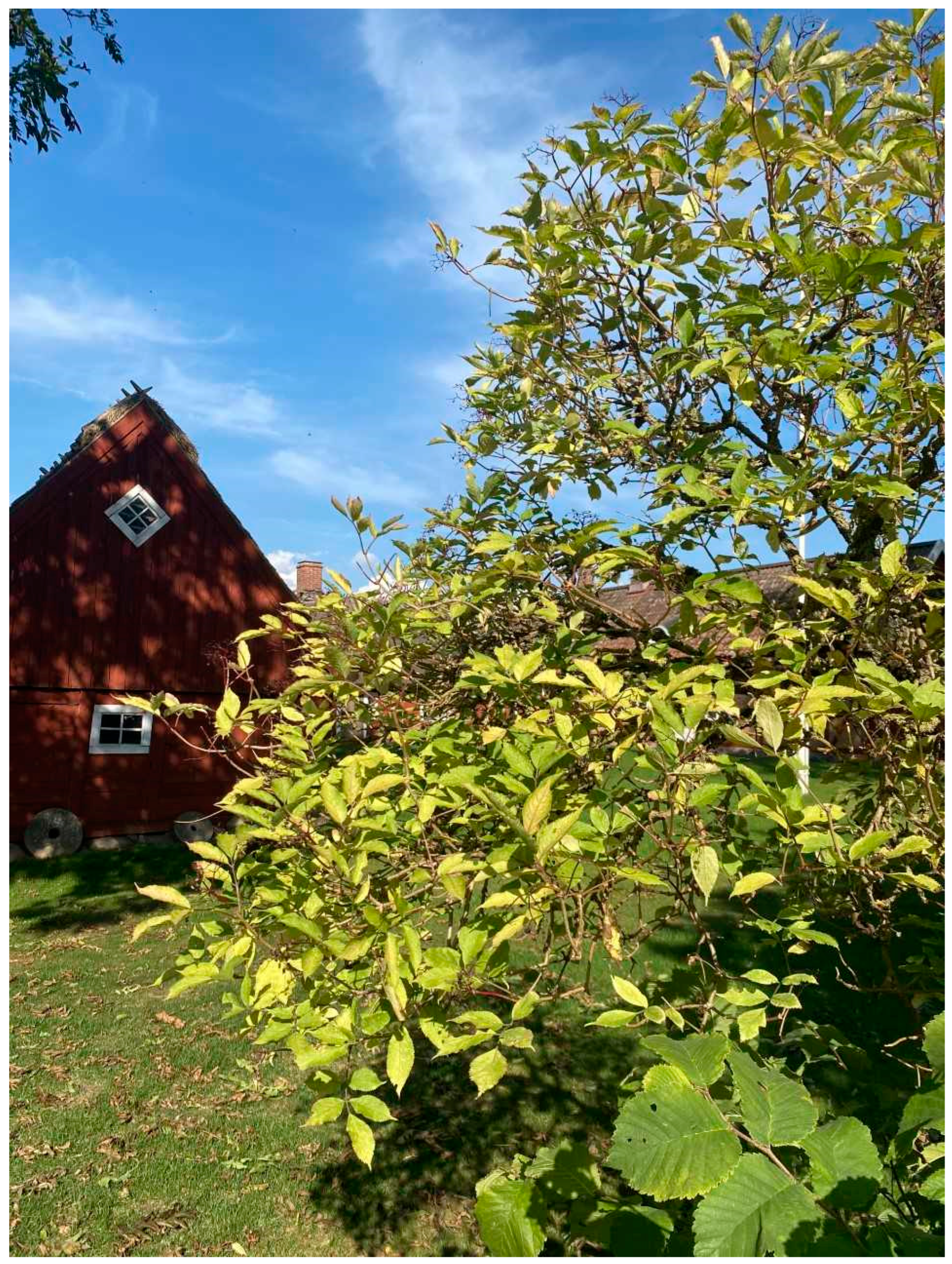
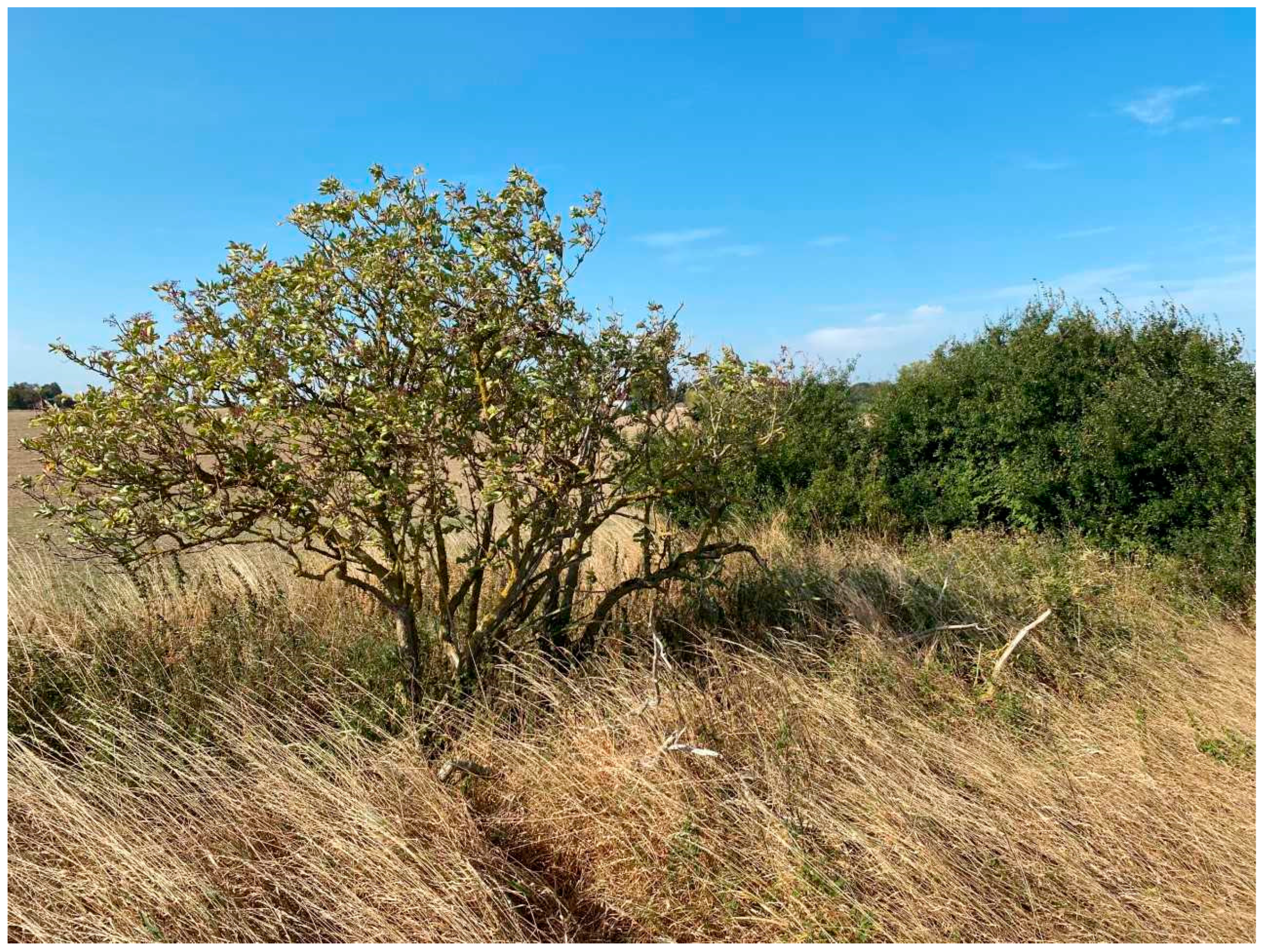

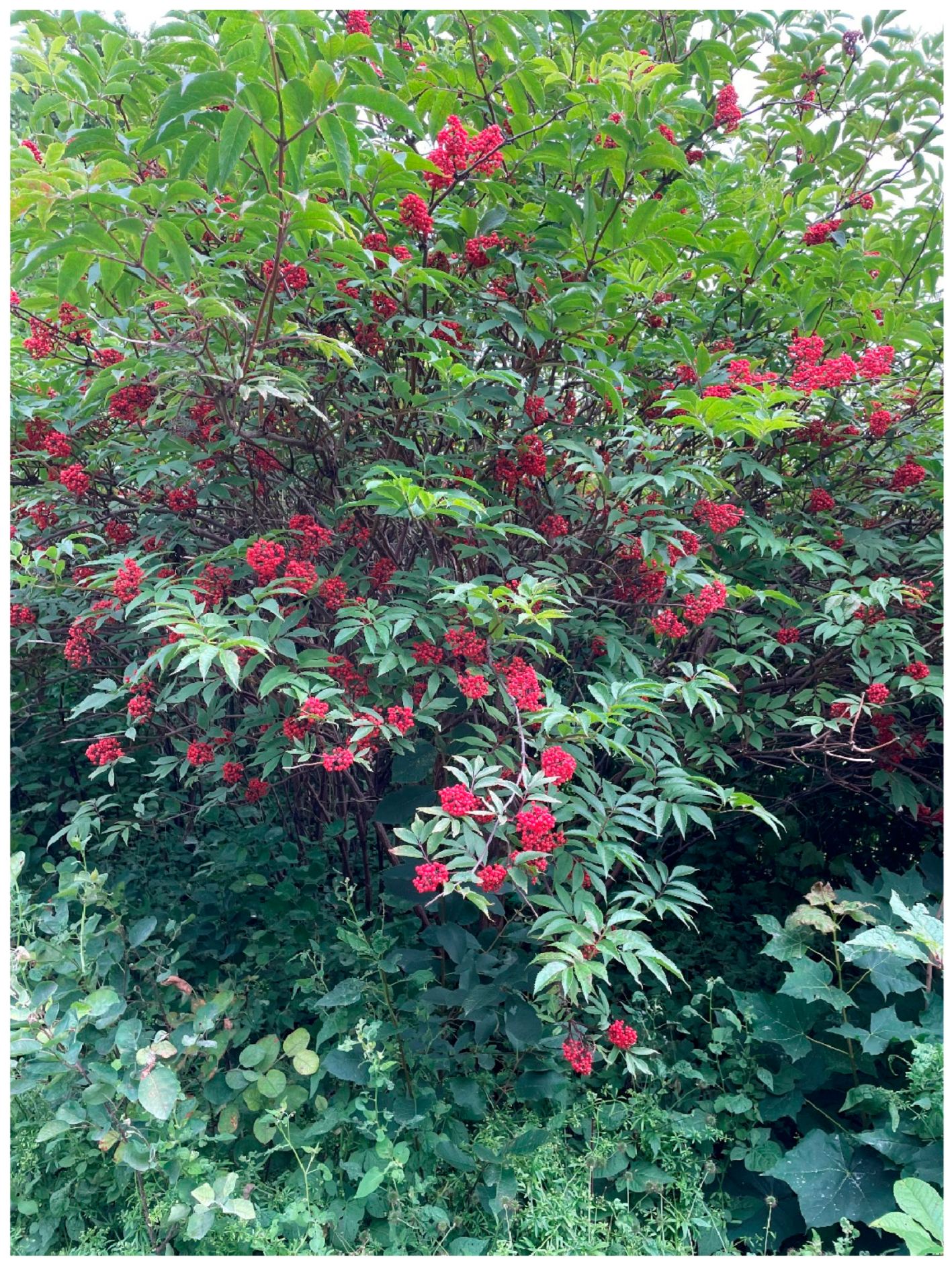

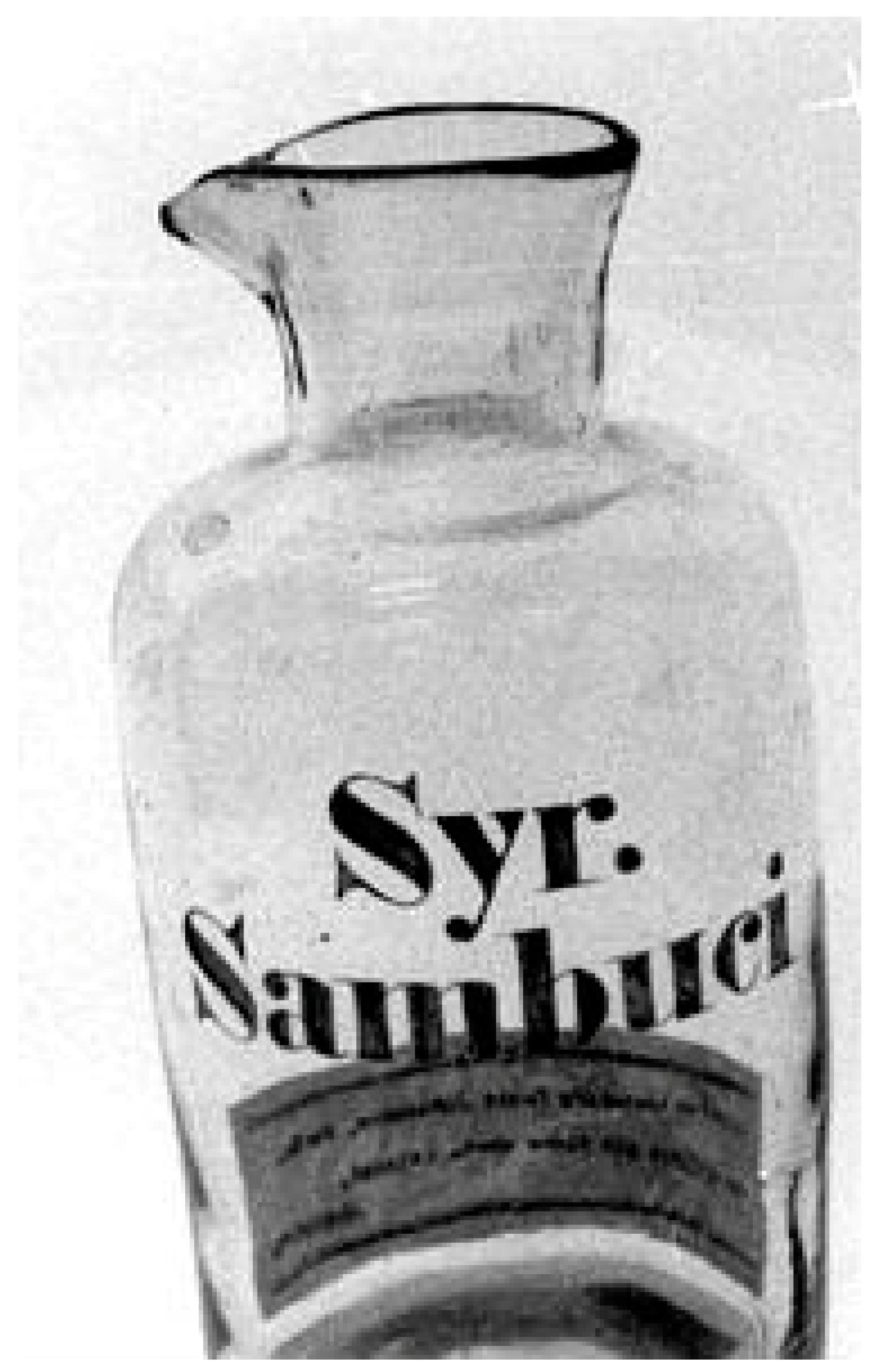
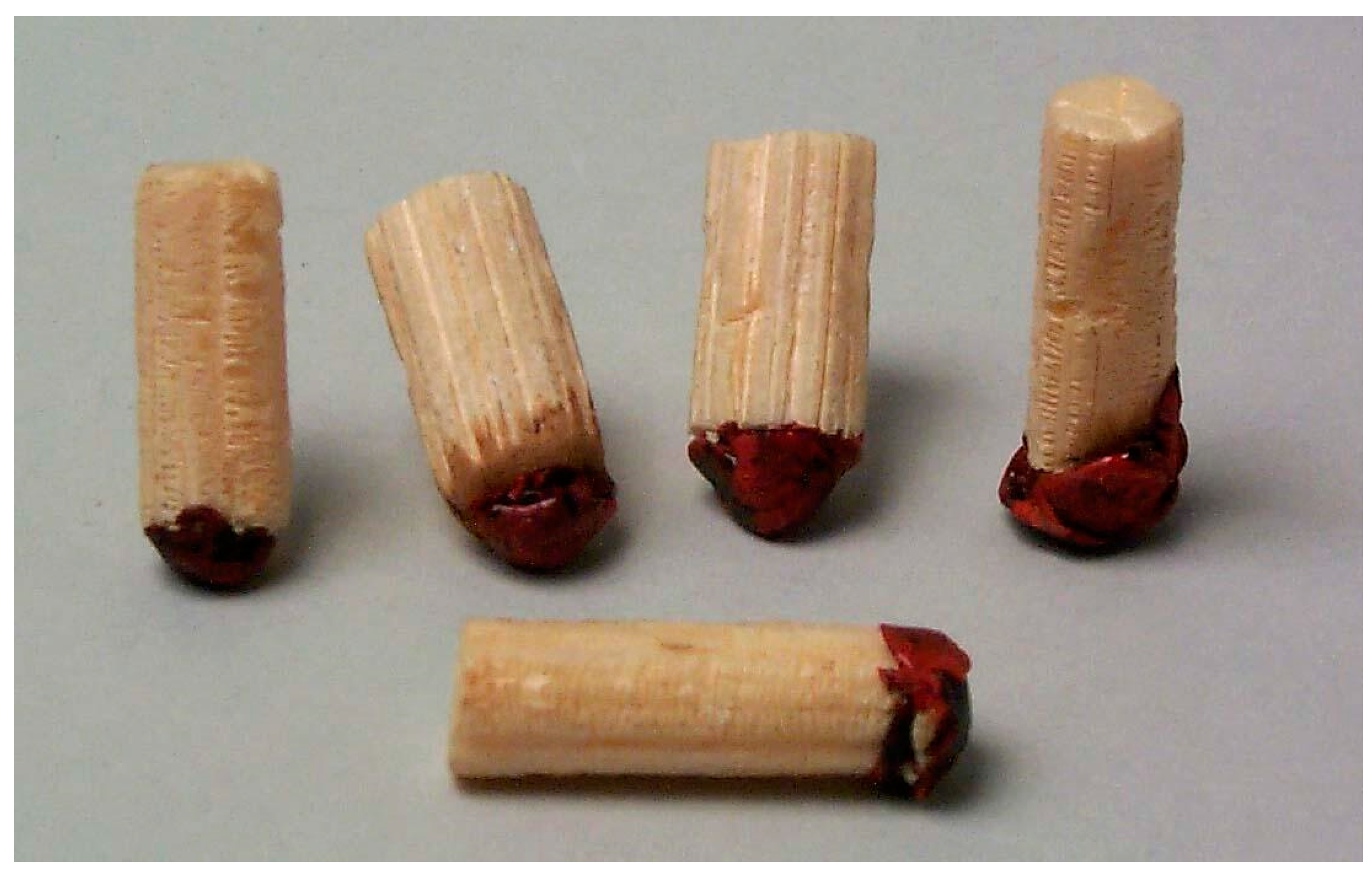
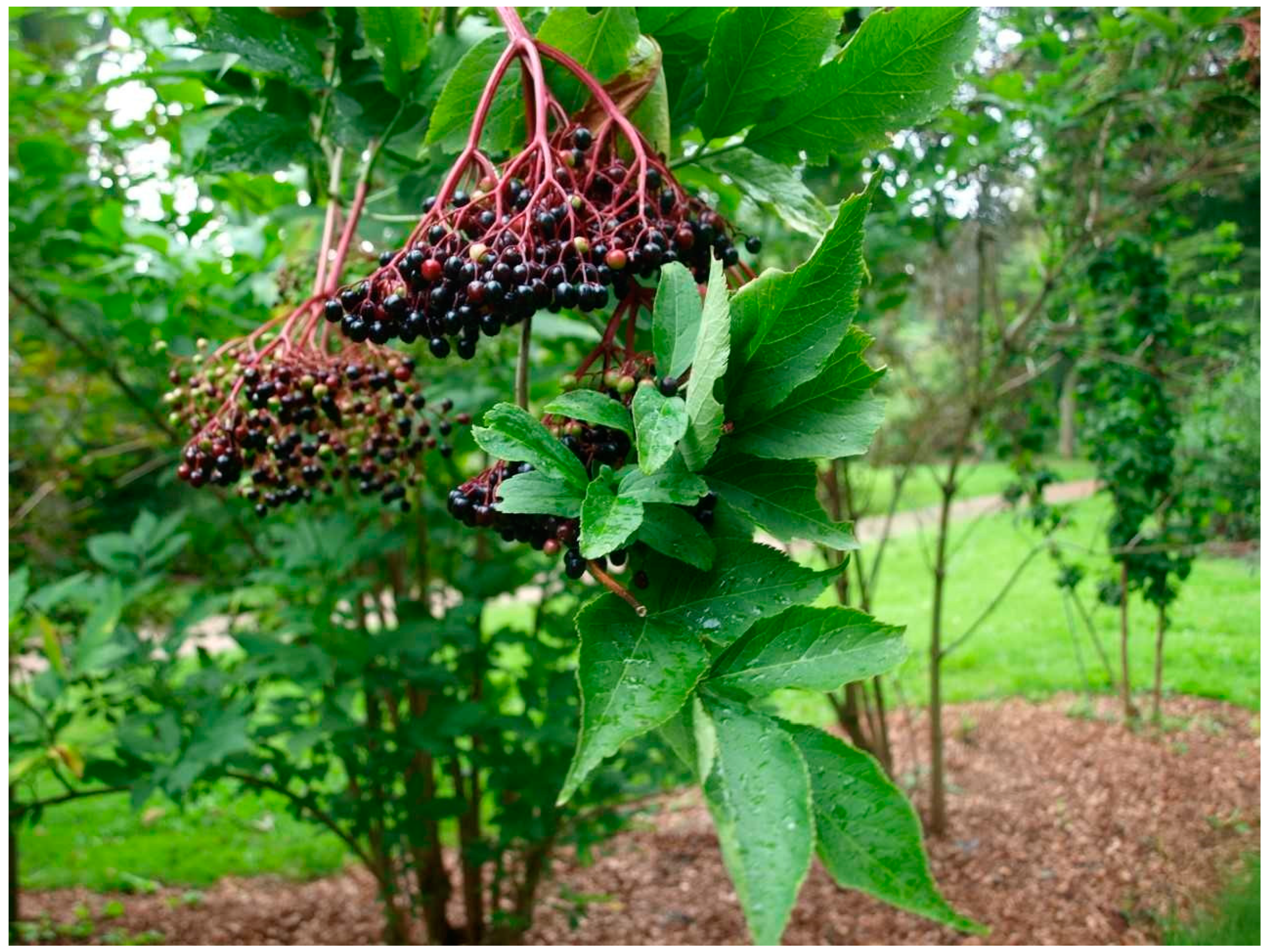





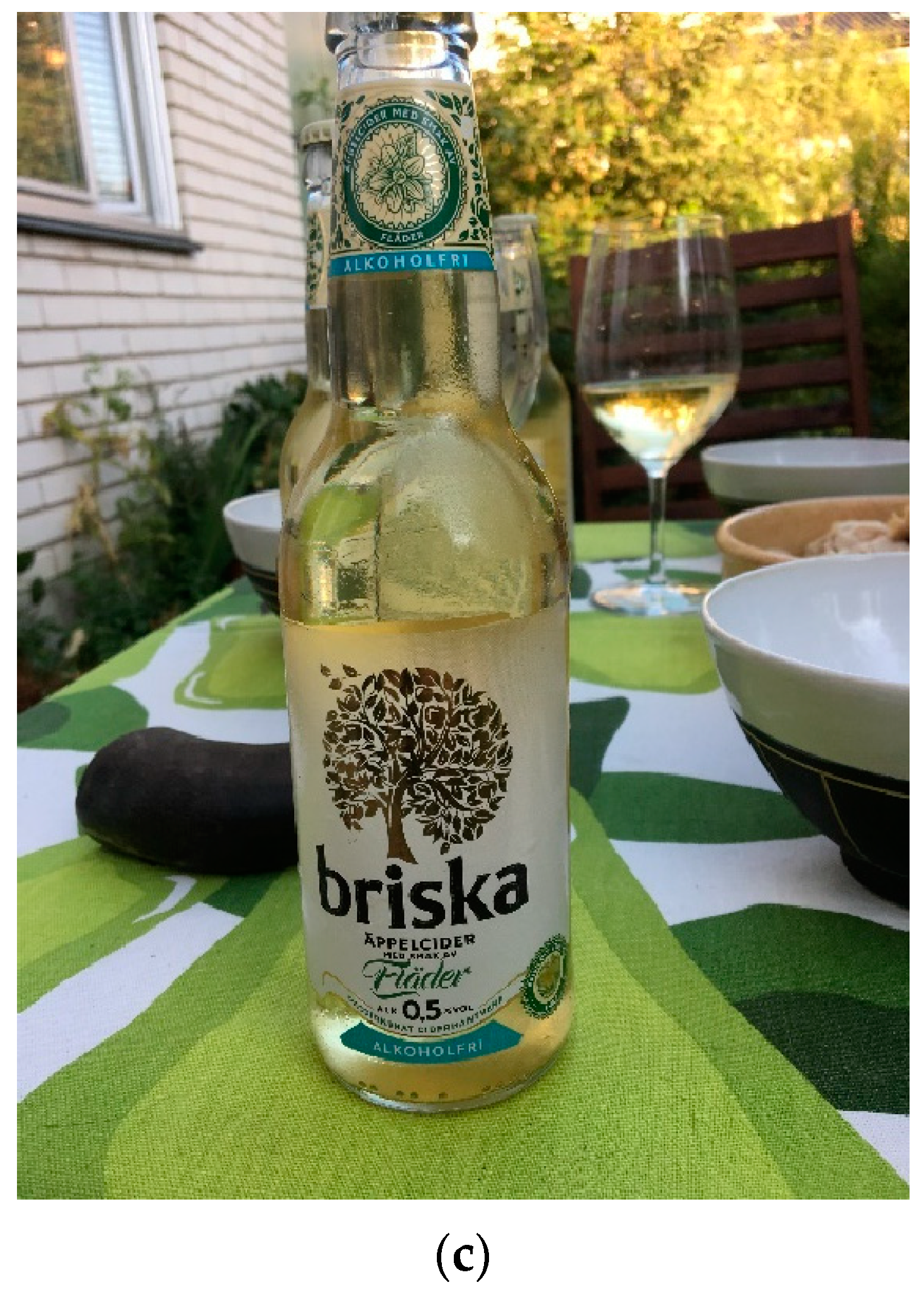

Disclaimer/Publisher’s Note: The statements, opinions and data contained in all publications are solely those of the individual author(s) and contributor(s) and not of MDPI and/or the editor(s). MDPI and/or the editor(s) disclaim responsibility for any injury to people or property resulting from any ideas, methods, instructions or products referred to in the content. |
© 2024 by the authors. Licensee MDPI, Basel, Switzerland. This article is an open access article distributed under the terms and conditions of the Creative Commons Attribution (CC BY) license (https://creativecommons.org/licenses/by/4.0/).
Share and Cite
Svanberg, I.; de Vahl, E.; Ingvarsdóttir Olsen, N.; Ståhlberg, S. From Supernatural to Ornamental: Black Elder (Sambucus nigra L., Family Adoxaceae) in Sweden. Plants 2024, 13, 3068. https://doi.org/10.3390/plants13213068
Svanberg I, de Vahl E, Ingvarsdóttir Olsen N, Ståhlberg S. From Supernatural to Ornamental: Black Elder (Sambucus nigra L., Family Adoxaceae) in Sweden. Plants. 2024; 13(21):3068. https://doi.org/10.3390/plants13213068
Chicago/Turabian StyleSvanberg, Ingvar, Erik de Vahl, Navarana Ingvarsdóttir Olsen, and Sabira Ståhlberg. 2024. "From Supernatural to Ornamental: Black Elder (Sambucus nigra L., Family Adoxaceae) in Sweden" Plants 13, no. 21: 3068. https://doi.org/10.3390/plants13213068
APA StyleSvanberg, I., de Vahl, E., Ingvarsdóttir Olsen, N., & Ståhlberg, S. (2024). From Supernatural to Ornamental: Black Elder (Sambucus nigra L., Family Adoxaceae) in Sweden. Plants, 13(21), 3068. https://doi.org/10.3390/plants13213068





